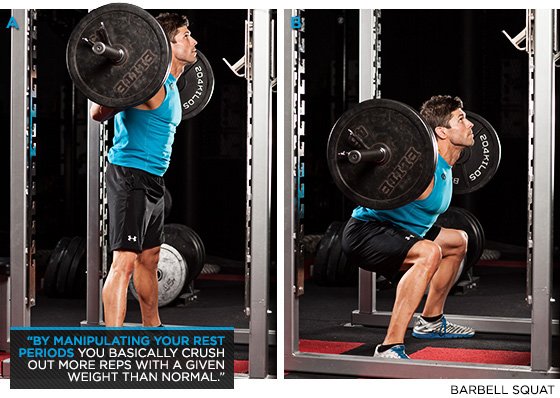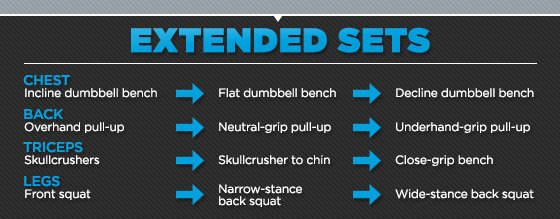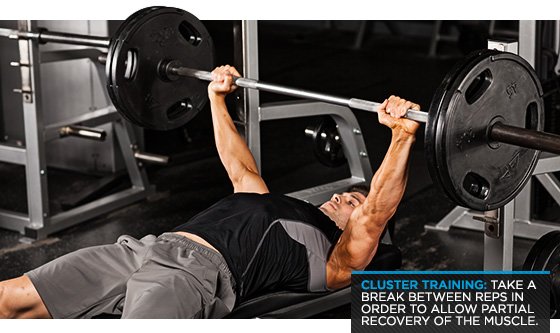Not seeing the results you want can put you in a vicious cycle. You lose motivation, your workouts suffer, and then you see even fewer results. It can go on and on. Chances are you're just experiencing a plateau and need a stimulus to jumpstart gains. But how can you do this without starting over from scratch?
If you want to gain some serious size you better have a good plan to do it. Step 1 is basic: Crank up your volume. You need to do damage to muscles if you want them to grow, and the normal handful of reps isn't going to cut it. Maybe you tried this before by throwing in an extra set or two, and it didn't work. If this was the case, try an extended set.
Like protein powder, extended sets can come in a variety of flavors, but you'll never top the classics: rest-pause, mechanical advantage, and clusters. Each of these modifications on the traditional set/rest arrangement will help you get more mileage out of your training, but they are not to be taken lightly. Only attempt them if your training and nutrition are in line.
If they are, however, you'll see one hell of a return.
1 / Rest? You Mean Pause.
The rest-pause is as simple as it is effective. By manipulating your rest periods you basically crush out more reps with a given weight than normal.

Start by doing a normal set of a given exercise. Then rest just 15-20 seconds and attempt to pump out as many more reps as possible. If you've done your first set right, you'll probably only get a few more. It's an honorable goal to shoot for half as many reps as you did on your original set, but don't be disappointed if you only end up getting 1-3 more.
Here's how it works:
- Perform 6 reps of a back squat
- Rest 20 seconds, then get back under the bar
- Do 3 more reps
- Try not to fall down
You can implement rest-pauses on all your sets, or you can save it for your last set as a way of destroying the muscle. While you can try to do multiple extra rest-pause sets consecutively, you should probably shoot for only 1-3. The chances are good that you won't be able to do any more than that anyway.
2 / Take Advantage!
The mechanical advantage extended set starts off identical to a rest-pause. You perform a traditional set, take a brief rest, and then attempt to bang out some more. This technique has one key difference, however. Instead of performing the same movement in follow-up set, you'll modify it in a way that makes it easier in order to get those extra reps.
This method can be used with almost any exercise if you're creative enough. The most common techniques involve changing your grip or stance. Here are a few examples:

The mechanical advantage extended set is a great way to focus on bringing up lagging body parts. As with rest-pause, you can either do all your sets this way or save it for an extra burnout on your last set.
3 / Clusters
Ah, clusters. This grueling training method shouldn't be used by anyone other than advanced trainees. Cluster training allows you to get more reps with a heavy weight and is great for adding size and strength.
Cluster training takes advantage of intra-set rest periods. That means you take a break between reps in order to allow partial recovery of the muscle. One of the most commonly used clusters is a takeoff on the tried-and-true 5 x 5 method and looks like this:
- Take 90 percent of your 1-rep max
- Perform 1 rep and rack the bar
- Wait 20 seconds
- Repeat until you've done 5 reps

This is an effective way of coercing your body into doing extra work. But what if you want to do more than 5 reps? Simply use a weight that would normally only allow 1-3 reps less than the total amount of reps you're going to do. For example:
- Use a 6-rep max
- Perform 2 reps
- Rest 20-25 seconds
- Repeat 3 times for a total of 8 cluster reps
By using cluster training, you will perform 8 reps with a weight that you would have traditionally only allowed you to perform 6. If you're wondering when to use them, clusters work well during intensity-oriented training phases.
It bears repeating that cluster training is an advanced training method that requires you have a solid base of training and an accurate idea of your strength. Don't overestimate your strength on clusters, because it absolutely will result in a bad situation and possibly injury. Done right, they're a game-changer.

No comments:
Post a Comment